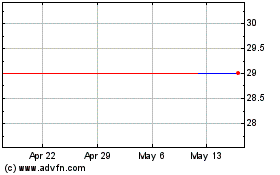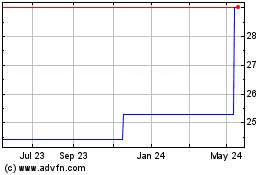New Zealand Stocks Lower, Regional Markets Likely to Follow
January 20 2016 - 8:00PM
Dow Jones News
The New Zealand share market, the first market to open in Asia,
has fallen more than 1% in early trading Thursday, after a volatile
session for global markets overnight.
Other regional markets are likely to follow suit, although the
pullback seen in the S&P 500 from midway through the U.S.
session has calmed futures predictions for the Asian session, said
Angus Nicholson, a market analyst at IG in Melbourne.
The Australian stock exchange is one of the only markets in Asia
looking to open in positive territory, helped by bank stocks that
look set to pare steep losses. In Japan, the Nikkei is set to
plunge deeper into technical bear market territory.
The Dow Jones Industrial Average fell 249.28 points Wednesday,
but major U.S. stock indexes pared early losses in the final hour
of trading, as the wide swings that have characterized markets in
2016 continued.
The Dow industrials lost 1.6% to 15766.74. The S&P 500
declined 1.2%, while the Nasdaq Composite lost 0.1%. At one point
earlier in the session, the Dow average was off more than 500
points, as falling oil prices and worries about global growth
weighed on markets.
Grant Williamson, a New Zealand-based investment adviser, said
the late bounceback in the U.S. provided a little bit of
encouragement for the New Zealand market, but he still expects
trading weakness, as some nervous New Zealand investors exit the
market. The NZX-50 index lost 1.03% in early trading, to
6050.73.
Michael McCarthy of CMC in Sydney said Thursday would be a key
trading day for markets, and could set the tone for the rest of the
year. Some investors would argue that the late pullback in U.S.
stocks showed that the bottom had been hit, he said, while others
would say that the wildly volatile session suggests things are
about to get a whole lot uglier.
Mr. McCarthy said a number of key indexes have hit very
important support levels. "If they bounce off those levels, that
will give a lot of investors and traders, particularly technically
based investors and traders, the confidence to buy into the
market." If that happens, he said there could be significant rises
over the next week.
"However, the other is just as possible at the moment," he said.
"If markets sell off over the next 24 hours and break those support
levels that's likely to bring in further selling. So it's a very
important couple of trading sessions for the future of
markets."
ANZ Bank said investor nervousness is on the cusp of turning to
panic in global markets.
"Those who have tried to catch falling knives are nursing some
ugly wounds as commodities and equities fail to find floors," the
bank said in a research note, adding it suspects it will be some
time before calm returns to markets.
In Japan on Wednesday, the Nikkei Stock Average fell 3.7%
pulling the index into bear territory—commonly defined as a 20%
drop from a recent high. Hong Kong's Hang Seng Index dropped 3.8%,
but losses were more muted on China's Shanghai Composite Index,
which fell 1%. In Australia, the S&P/ASX 200 fell 1.3% and in
Europe the Stoxx Europe 600 fell 3.2%.
U.S. crude prices had their biggest one-day percentage loss
since September, falling below $27 a barrel, further punishing
energy stocks.
Write to Kate Geenty at kate.geenty@wsj.com
(END) Dow Jones Newswires
January 20, 2016 19:45 ET (00:45 GMT)
Copyright (c) 2016 Dow Jones & Company, Inc.
Australia And New Zealan... (ASX:ANZCD)
Historical Stock Chart
From Dec 2024 to Jan 2025

Australia And New Zealan... (ASX:ANZCD)
Historical Stock Chart
From Jan 2024 to Jan 2025
